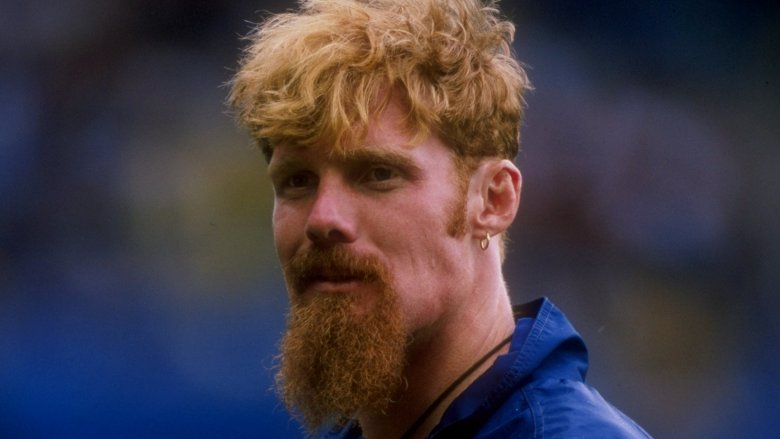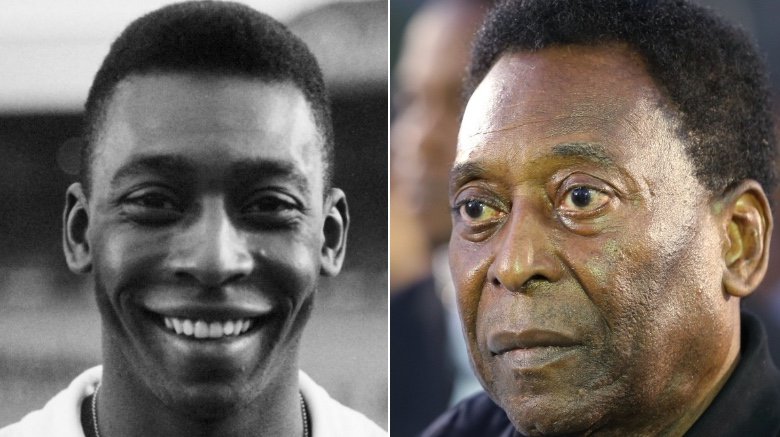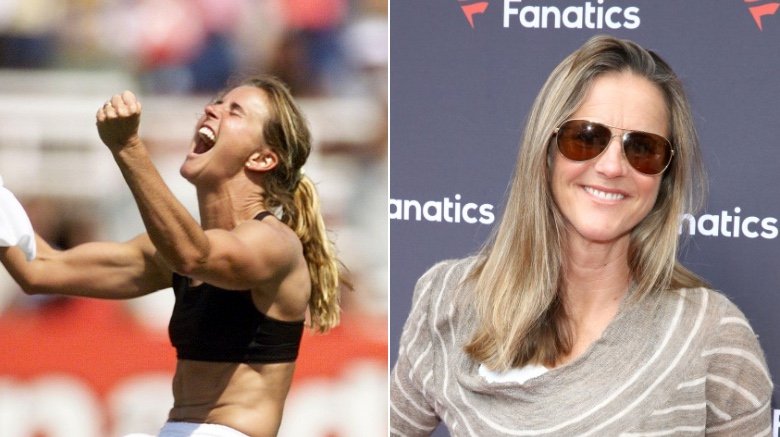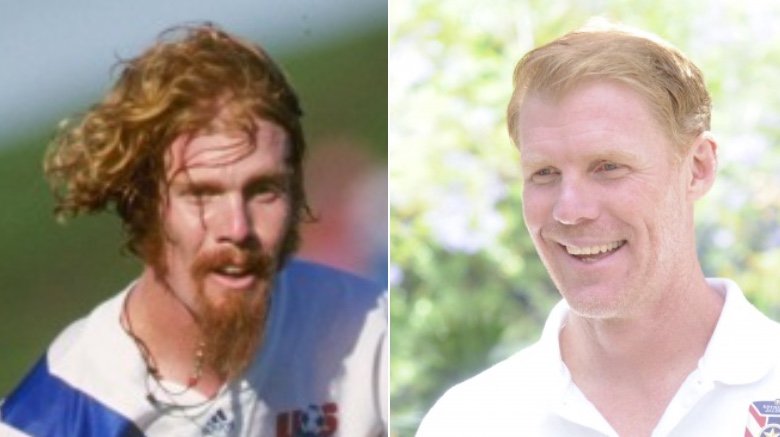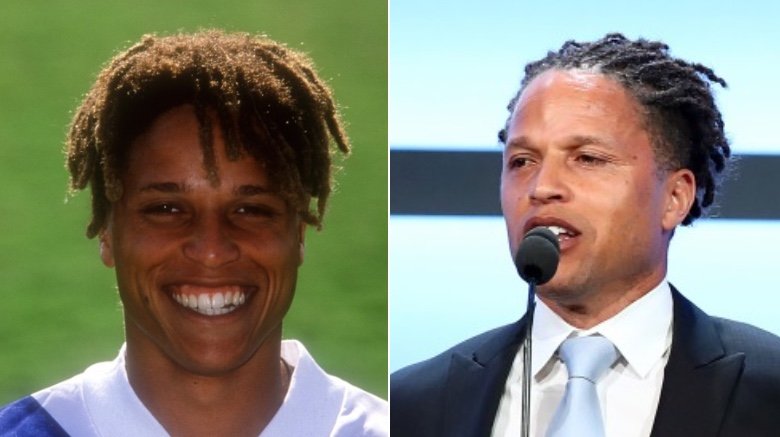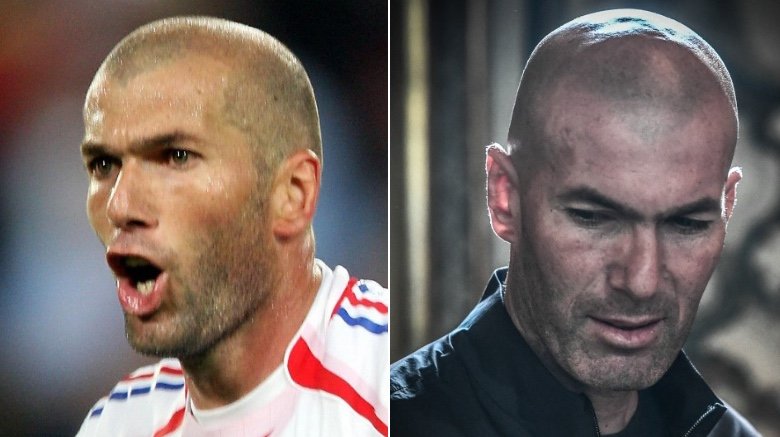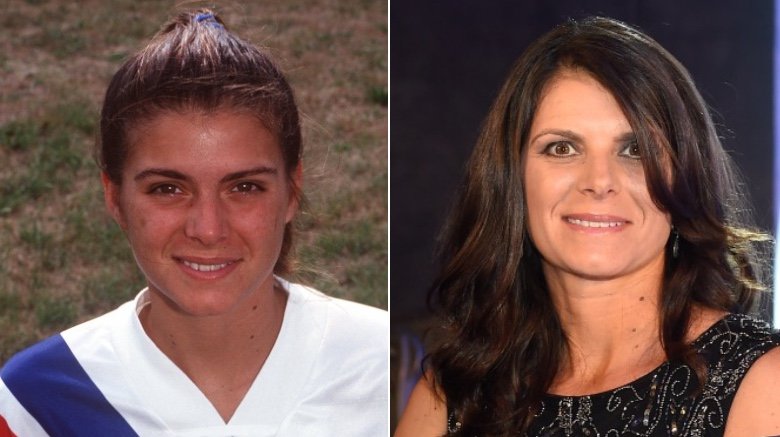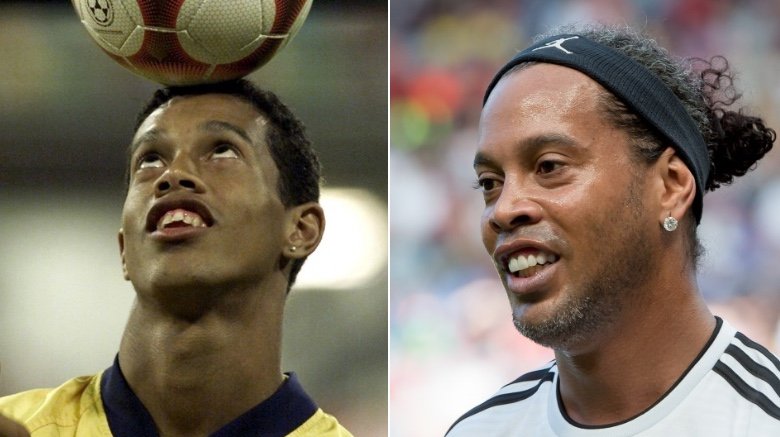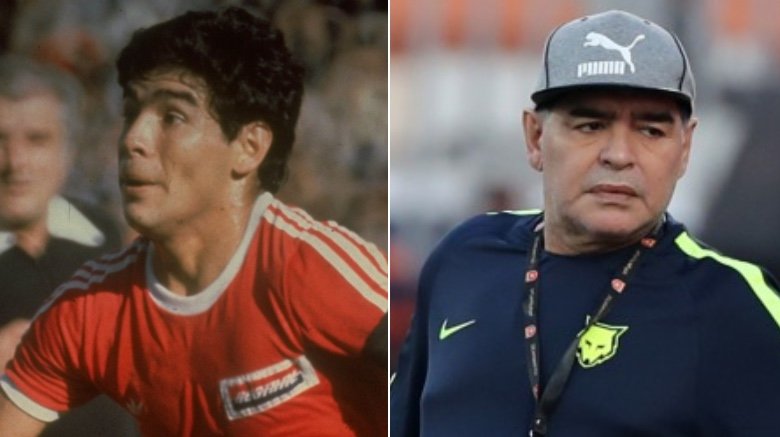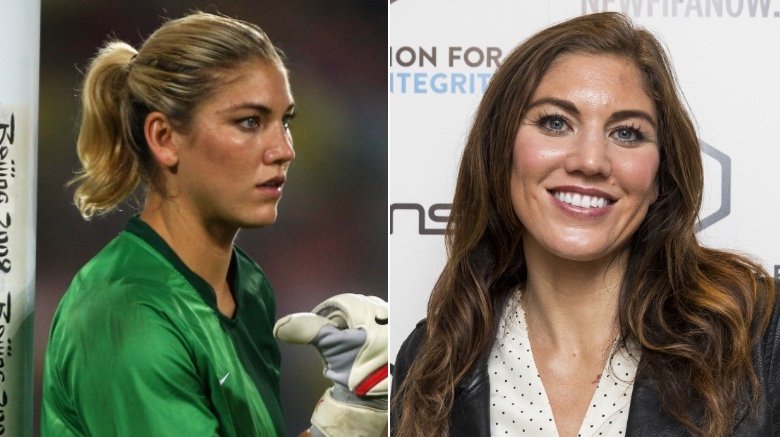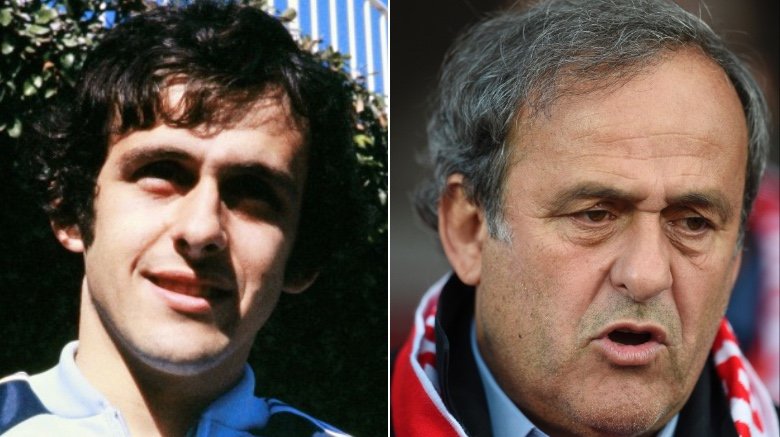World Cup Athletes Who Look Completely Different Today
Every four years, the greatest soccer (or football, if you're from pretty much anywhere other than the United States) players from across the globe join up with their fellow superior athletes from their home nations and hit the pitch to compete for the FIFA World Cup. While most are stars in various soccer club leagues around the world, the chance to play (and excel) for the national team is a shot at glory that can also propel an athlete to international stardom as billions of fans around the world watch them do their thing.
But after the $20 million trophy has been hoisted and these glorious athletes have gone on their victory tours, players return to their teams, eventually retire, and settle into their lives. Where are these legends today? We're so glad you asked. Here's an update on what happened to notable competitors of World Cups past — male and female — and what they look like today.
Pelé
The man born Edson Arantes do Nascimento is like the Frank Lloyd Wright of architecture. If you don't know anything about architecture, you know the name Frank Lloyd Wright, and even if you've never watched a minute of soccer, you know that Pelé is one of the greatest soccer players of all time.
In the 1958 World Cup, the 17-year-old scored three goals for Brazil in its semifinal win over France, and then another three more in his team's championship win over Sweden. Pelé was part of Brazil's Cup-winning squads in 1962 and 1970 — he helped clinch the title in that '70 cup with a goal in the final against Italy. Pelé retired in 1974 but didn't stay that way for long. He joined the New York Cosmos of the burgeoning North American Soccer League and played in exhibition games around the world throughout the decade.
Since his playing days, he's served as a worldwide ambassador for soccer, as a spokesman for Viagra, and composed the soundtrack for a film about him. In 1999, the International Olympic Committee named him "Athlete of the Century," so that's a pretty big deal.
Brandi Chastain
The U.S. men's national soccer team has never done that well in the World Cup. In 2002, the squad advanced to the quarterfinals, which is the only time it got past the round of 16. If you're a patriotic American soccer fan, you might want to check out the FIFA Women's World Cup, where the USA has won the whole thing three times. In the 1999 final at the Rose Bowl in Southern California, Brandi Chastain scored on the fifth kick in a penalty shootout, clinching the title for team USA. In celebration, she fell to her knees and ripped off her jersey, fists clenched in triumph. That title — and the famous photograph of Chastain being awesome — gave women's soccer a big popularity boost in the U.S.
Off the playing pitch, Chastain has stayed close to the game. She's coached at almost every level, including assisting with women's soccer at Santa Clara University, girls teams for the Olympic Development Program, the boys team at a private Catholic high school in San Jose, Calif., and her son's youth soccer squads.
In 2018, she made news again when she was inducted into the Bay Area Sports Hall of Fame. At the ceremony, a plaque of Chastain that looked nothing like Chastain was revealed...and went viral. The person on the plaque looks like some combination of Gary Busey and Eleanor Roosevelt. Chastain looks a lot different today, but not that different.
Alexi Lalas
Pro soccer now contends with the NBA and NHL in terms of attendance and has finally put to rest the long-held notion that the sport couldn't take hold in America — an evolution that began in earnest with the 1994 World Cup. That marked the first time the international tournament was held in the United States, and as the host squad, the American team got an automatic berth in the tourney. The sports media, wanting to give Americans somebody to root for, profiled and presented the team's best and most colorful players, and none was more ready for their closeup than defender Alexi Lalas.
He struck quite the image on the soccer field: a tall, gangly guy with a sunny disposition who looked like the lead singer of the Spin Doctors (hey, it was 1994) but with messy red hair and a long red beard that sometimes had beads braided into it.
The U.S. was eliminated by Brazil in the knockout stage at the '94 Cup, and then Lalas turned pro. After a brief stint in Italy, Lalas signed with the New England Revolution for Major League Soccer in 1996, and played with three more teams until his retirement in 2003. He also fulfilled his destiny of looking like a musician by actually being a musician, releasing a couple of albums with his band, the Gypsies, along with some solo stuff. Lalas now works as an analyst for Fox Sports. (He covers soccer.)
Cobi Jones
Cobi Jones was another oft-covered member of the 1994 American World Cup squad. He was young, good-looking, media savvy, and rocked some pretty awesome dreadlocks. It didn't matter that he didn't score any goals for team USA in its World Cup campaign (although he's played in more international matches than any American ever). He had a memorable image and capitalized quick. MTV hired the affable athlete to host Mega-Dose, a magazine show about health issues facing Gen-Xers — topics like vegetarianism, the safety of club drugs, and tattoo hygiene.
After the World Cup hype died down, Jones joined Major League Soccer and played 12 seasons with the Los Angeles Galaxy. He stuck around as an assistant coach for the team for two years, and at the time of this writing, he's still with the club serving as its TV analyst. In 2011, he was elected to the National Soccer Hall of Fame.
Zinedine ZIdane
Zinedine Zidane is a national treasure in France; probably the greatest soccer player the nation has ever produced. This guy led the French team to the 1998 World Cup championship and to the runner-up spot eight years later, but to casual soccer fans from non-francophone countries, Zidane will forever be linked to an infamous and ugly incident in the 2006 World Cup final. In extra time, Italy's Marco Materazzi approached Zidane, and muttered, well, something.
The speculation was always that Materazzi trash-talked Zidane in some way, with the consensus being that he insulted Zidane's mother. "My mother died when I was 15, I would never have insulted his," Marca said in 2016 (via USA Today). "I spoke about his sister." Zing!
Zidane responded with some casual violence, head butting Materazzi in the chest. Refs quickly issued Zidane a red card (aka an ejection), and Italy went on to win on shootout kicks. Who knows what would have happened if France still had its star player on the field.
Making good on a rumor that he would retire from playing after the 2006 World Cup, Zidane moved to the front office of his pro team, Real Madrid. He worked his way up the club's coaching ranks, first leading the Real Madrid youth academy, then the squad's B team, and then coaching the top-line Real Madrid squad proper. Zidane and his players won a bunch of European titles during his two-year stint.
Mia Hamm
Mia Hamm is probably the best American soccer player of all time — among women and men. She dominated the sport for years and has been a champion at every turn. After joining the women's national team at the age of just 15, she went on to win the Women's World Cup in 1991 and 1999, win a gold medal in the Olympics with Team USA in 1996 and 2004, and win four straight college championships at the University of North Carolina at Chapel Hill. She once held the record for most goals scored in international play. In 2004, the year she retired from playing, she was the only American woman named to FIFA's list of the greatest living soccer players. Not too shabby.
Hamm has focused on her personal life in recent years, settling down with her husband, Boston Red Sox legend Nomar Garciaparra, to raise a family. She also formed the Mia Hamm Foundation, a bone marrow research organization created in honor of her late brother, who died from a rare blood disease. However, she can't totally stay away from the sport — she co-owns the Los Angeles Major League Soccer club.
Ronaldinho
A hugely successful league soccer player, the Brazilian legend born Ronaldo de Assis Moreira led Barcelona to two La Liga titles and a UEFA Champions League, uh, championship in the 2000s. Along the way, he won two straight FIFA world player of the year awards. Ronaldinho was arguably even better in international play. He suited up for Brazil in nearly 100 matches, including two World Cups, and he scored 33 times. His best games came in the 2002 World Cup, scoring two goals and two assists to help Brazil win the tournament.
In 2017, Barcelona announced that they'd signed Ronaldinho to become a "Club ambassador and representative at various events and activities over the coming years," which includes a spot on the exhibition game roster. In 2018, the forever good-time guy was in the news for something very unrelated to soccer. He announced plans to marry his girlfriend, Priscilla Coelho ... as well as his other girlfriend, Beatriz Souza. Sky News reports that the wedding will be for family only, although Ronaldinho's sister won't attend. Oh, and also, bigamy is reportedly a prison-punishable offense in Brazil.
Diego Maradona
Along with Pelé, Maradona is easily one of the best soccer players of all time. (FIFA co-awarded its player of the 20th century prize to both guys.) The 5'5" midfielder and striker, aka El Pibe de Od ("The Golden Boy") played in four World Cup tournaments for his home nation of Argentina. In 1986, he captained his team to a win over the dominant squad from West Germany and was named the best player of the tournament. That honor was probably because of a goal he scored in the semifinal against England — he dribbled a good 60 yards past five opponents in what was named the "Goal of the Century" by FIFA in 2002.
Maradona retired from international play after the 1994 World Cup and played for various squads around Europe until 1997, at which point he got into coaching, including for the Argentine national squad. (Notable moment: Maradona's players made it all the way to the quarterfinals of the 2010 World Cup.) The Golden Boy headed to the 2018 World Cup in Russia as an analyst, where he was photographed crying when his beloved Argentina lost in a shocking upset to Croatia in the group stage.
Hope Solo
Goaltenders aren't often the stars of the team, but there was never a goalie quite like Hope Solo. In addition to gold medals with the USA women's soccer team in 2008 and 2012, Solo blocked the ball in three World Cup tournaments: 2007, 2011, and 2015 — the year her squad won it all. In the latter tournaments, Solo was awarded the Golden Glove for best goalkeeper, and in 2011, she received the Bronze Ball (the third-best player in the tournament), marking the first time a goalie was so honored.
In 2011, Solo's victory lap included the requisite stint on Dancing with the Stars, but that did not go well. In her 2012 memoir Solo: A Memoir of Hope (via Entertainment Tonight), the goaltender wrote that partner Maksim Chmerkovskiy was "rough and mean with me ... He wanted my head in a specific position. To achieve that, he slapped me across the face. Hard."
In 2014, Solo was arrested after a domestic dispute at her home outside Seattle. She was charged with two counts of fourth-degree assault, although the charges were later dropped. In 2018, Solo unsuccessfully ran for president of the U.S. Soccer Federation. That's the same organization she and other players sued for wage discrimination, claiming male players get four times the salary of female players, despite the women's side generating far more income.
Michel Platini
In the 1970s, Platini became one of the most accomplished French soccer players of all time. Playing for Nancy, he led the team to the Ligue 2 championship in 1975 and almost scored a medal with the French national team in the 1976 Olympics. A couple of league titles with Italian team Juventus were bookended by two straight World Cup semifinals berths, in 1982 and 1986. Soon thereafter, he coached the French national team and then joined the World Cup organizational board.
Platini has known soccer glory, and he's also known soccer disgrace. In 2018, he unabashedly admitted that when he was part of the 1998 World Cup organization committee, he sort of helped rig it. "France-Brazil in the final, it was the dream of everyone," Platini told a radio show on France Bleu Sport. And so, the committee conspired to arrange the teams in the tournament's initial group stage to increase the likelihood of that pairing, and indeed, the two teams didn't meet until the final.
Was Platini punished by FIFA in any way for this admission? Nope — when he came clean he was already in the middle of a four-year ban from soccer (reduced from eight) after it was discovered that he'd received a secret, illegal payment (aka bribe).

